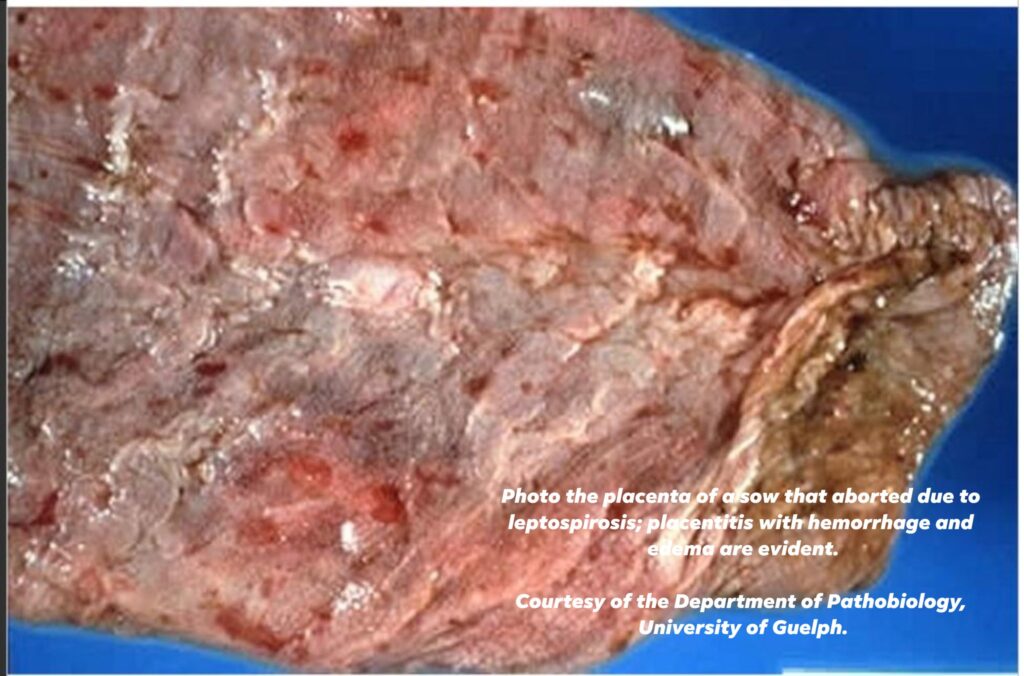
This affects both gilts and sows and the causes range from mismanagement, fever, infections of the uterus and poisoning.
Effects: The sow/gilt will abort recognisable foetuses before day 110 of gestation, after which production of dead foetuses is classified as a stillbirth. Sows may be visibly ill before abortion occurs or remain normal.
Causes
Death of the conceptuses may occur early from hormonal causes as four live foetuses are required to maintain an early pregnancy. After implantation, infection is the main cause of abortion, indirectly through fever or directly as a result of the infection of the foetus. Fever is the cause of abortion in erysipelas and other feverish diseases. Invasion of the foetus can occur in many viral and bacterial diseases. In some, foetal invasion results in death and dead foetuses reabsorbed, and in older pregnancies, the foetus may become mummified and later stillbirth may occur. All combinations of normal, resorbing, and mummified foetuses may be aborted. Major infections capable of causing abortion are Aujeszky’s Disease, brucellosis, enterovirus infections, leptospirosis, parvovirus, PRRS, swine fever and toxoplasmosis. Ingestion of the mould toxin zearalenone is also capable of causing abortion, as are management factors, such as high carbon monoxide concentrations.
Mode of transmission
Infectious causes of abortion are transmitted by the routes associated with the causal infection. Non-transmissible abortions occur.
Clinical signs
Sows may be seen to abort and the aborted material may be found on the floor of their accommodation. The sow may not appear ill in some cases (enterovirus, parvovirus, some leptospirosis), but in other diseases such as erysipelas, there is clear evidence that the sow is ill, off feed, and has evidence of the disease. In the case of erysipelas, high fever and the characteristic skin lesions are often found. The rectal temperature should be taken to establish the presence of fever. During or after abortion, the vulva may be bloodstained and the tail and hindquarters may be smeared with sticky discharge. As sows frequently eat aborted material, abortion is hardest to detect in loose-housed animals. Where abortion is missed, the termination of pregnancy may be detected only when an animal, previously known to be pregnant, fails to farrow, returns to oestrus or is identified following a pregnancy check. Abortion is recorded in pig herds as a routine. Abortions should be uncommon in a herd (fewer than 1%), but if they reach 2.5%, the cause should be determined. Management factors may be obvious and in zearalenone poisoning, enlargement of the vulvas of piglets and enlargement of the mammary glands in non-pregnant gilts. The presence of specific diseases may only be identified by laboratory examination of the aborted foetuses, vaginal discharges or blood from the affected sow.
Postmortem lesions
The products of abortion may be visible as embryos (large sacs 10-20 cm in length, with a central dark area, the embryo itself, from which blood vessels radiate) or as perfectly formed pig foetuses. These have their eyes closed and are hairless. They may be partially decayed, mummified or perfectly fresh with haemorrhages on their skins. The age of the foetus when death occurred may be determined by measuring foetal crown-rump length. Placentas may be absent, although they are sometimes passed surrounding aborted piglets. Fluid from the chests of aborted foetuses is used to detect infectious agents by culture or PCR and antibody to them may be present after 70 days gestation. Sows are rarely examined postmortem, but ageing corpora lutea are visible in the ovaries and the uterus may be enlarged, although it rapidly returns to normal. Lesions of a causal infectious disease may be visible but laboratory examination of vulva discharge or uterine contents may be required.
Treatment and prevention
The ability to prevent further abortions varies, depending on the cause. For example, zearalenone toxicity can be eliminated rapidly by feeding clean rations. Carbon monoxide poisoning can be eliminated by adjusting gas heaters. Toxoplasmosis may be prevented by stopping contamination of pig feed by cat faeces. Erysipelas can be treated easily with penicillin and leptospirosis with tetracyclines. Solid immunity follows the elimination of these infections. Less specific infections of the uterus can be eliminated, but ideally, the animals should be culled as persisting infection may reduce fertility.
To control abortion, sows can be vaccinated against erysipelas and parvovirus. In some countries, vaccination against leptospirosis, Aujeszky’s Disease, swine fever and PRRS is also possible. Vaccination requires at least 14 days to protect against an agent and may not protect against venereal infections. There are no vaccines for enteroviruses. Brucellosis is notifiable and controlled by other means. The aborted material should be treated as infectious and correctly discarded, with disinfection as appropriate.
Animals which have aborted should come back into oestrus within 10 days and may then be served. The exception is if body condition has been lost when consideration should be given to increasing feed and delaying service. Those that do not return to oestrus or do not hold to the next service, should, unfortunately, be culled.
Special note
Some infectious causes of abortion (Swine Fever, African Swine Fever, Brucellosis) are notifiable and some, such as Brucellosis and Leptospirosis, can infect humans handling the products of abortion. Please ensure that strict hygiene is practised.